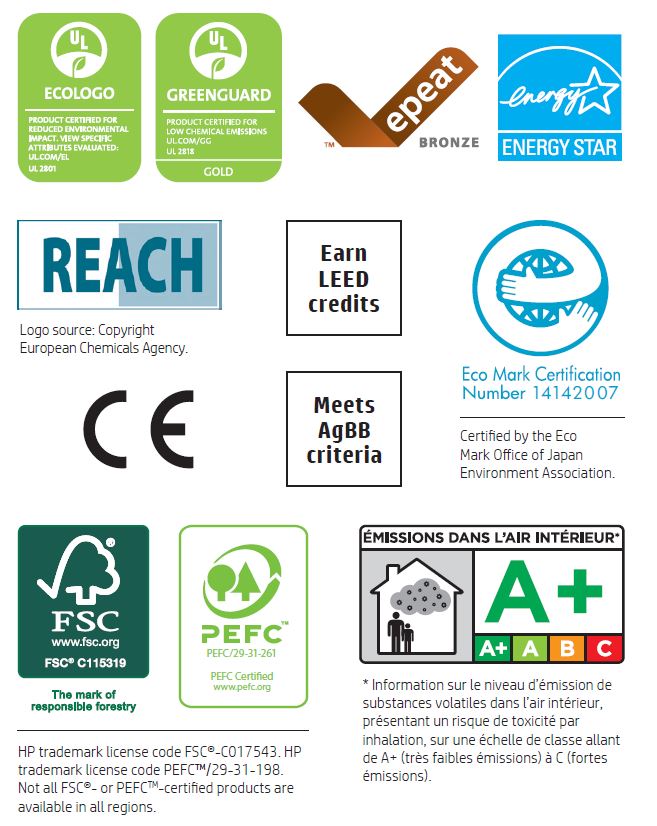
Either if you are concerned about regulations, or if your customers are becoming more green sensitive, or simply if you care about your operators, you may be interested to learn more about the key environmental advantages of HP Latex against eco-solvent technology.
I have summarized them in three major sustainability’s pillars: health, economics and environment.
About health
Let’s be clear: eco-solvent inks (by the way, ‘eco’ comes from economic, not ecological) are by definition made of a solvent vehicle, which can be hazardous and needs to be evaporated and carefully controlled. While we have seen an improvement in the smell of eco-solvent inks, that doesn’t mean that they are safer, and in fact they still carry the ‘dangerous goods’ logos in the cartridges, indicating the risk of health issues for anyone exposed to them.

In contrast, HP Latex inks are water-based, meaning that the main vehicle is water instead of solvent. Some competitors claim that latex inks do contain solvents, with the aim to create confusion. For sure, the ink is not simply pigments dissolved in water (otherwise you would be making ink at home!). HP Latex inks are in fact very sophisticated formulations, containing many other components like humectants, which ensure that the print head keeps wet, surfactants that allow the ink to better adhere to uncoated substrates, or the anti scratch agent that protect the print once cured, but none of those components are hazardous in the quantities we use in the ink or to print.
But don’t worry, you don’t need to be a chemist – HP takes this very seriously. The world of regulations is constantly evolving and becoming more complex, this is why at HP we have internal and external experts on environmental, health and safety, and a Design for Environmental program that actively designs our inks today so that they will be compliant with regulations that aren’t even written yet (link to GSE here). As Nils Miller - Ph. D. and Environmental Technology Expert at HP – says, “we can do this because we keep up with the Science of Safety”.
So if you have any doubt about the inks, simply look to the labels in the cartridges to see if an ink is hazardous or not.
About economics and energy consumption:
Although everybody cares about environmental, the fact is that no one is really willing to pay more for a sustainable print. So when it comes to use more environmental friendly technologies like HP Latex, we need to make sure it does not cost any extra cent to produce.
Recently, we have seen a lot of claims from our competitors regarding the energy cost of HP Latex mprinters, so let me deep dive on this.
Energy is a serious topic – we are all looking for ways to make printing more sustainable and energy consumption is part of the environmental foot print of the printer. And yes, we need heat (and 220V) to cure latex inks. What our competitors don’t say is that, with each new generation of HP Latex Printers, we have reduced by half the energy required to cure the ink, to the point of making it a non-issue. Eco-solvent printers also need heat to dry the prints, and often they require additional heater or special ventilation accessories to get the fastest print speeds they claim. Interestingly, the typical energy cost difference between the HP Latex 300 series and an eco-solvent printer of similar performance will be around $7.5 per month (using USA data) – an insignificant amount to be fair. Click here for more information on the energy consumption comparison.
Consider also that our HP Latex technology is similar to your home or office printer – you can put it in standby or switch off completely when you are out (at night, weekends…). This can compensate and even override the supposed energy advantages of eco-solvent printers, which are recommended to be kept powered on at all times to avoid the print heads from clogging. To support our affirmation, we have certified again our HP Latex 300 series to the latest standards of the Energy Star & EPEAT Bronze requirements, whereas most eco-solvent printers have not.

So don’t be confused by cost of energy claims: our continuous improvements have made this a virtual nonissue with the HP Latex 300 series.
About environmental certifications:
This is a very broad topic - the world of certifications. The only thing I can say here is that you need to look which ones are relevant for your customers and your applications. At HP, we make a constant effort to get the certifications and regulatory approvals needed for each market application, to help our customers succeed.
An important point to clarify here is that not all certifications refer to the same things. There are certifications like CE or Energy Star that refer to the printer. There are others like UL or Eco Mark that refer to the inks and cartridges. Others, like FSC or PEFC, refer to the substrates. Others like AGBB or LEED refer to the print itself. And others like the UL Greenguard refers to several things, in this case the ink, the substrate or the finished print. So if you wonder how eco-solvent inks achieve certifications like GREENGUARD, it’s simply because these certifications are related to the finished and degassed print, and not to the inks or the printer itself.
To help our customers navigate into this complex world of names and logos, we did a comprehensive map of the HP Latex 300 certifications you can see below. See the specific HP Latex 360 environmental credentials:

Learn more at General Environmental certifications and ecolabels overview.
Finally, let me say few words about VOC’s, as there is some confusion in the market and many certifications relate to that. VOC’s refer to Volatile Organic Compounds, and are strictly regulated as they have an impact in the quality of the air. And as it happens with the inks, the key point is if they are hazardous or not. If you use perfume every morning, you are emitting VOC’s – but don’t worry, are non-hazardous ones. HP Latex printers do emit a low level of VOC’s (not perfume, of course), but most important they emit ZERO level of hazardous VOC’s (also known as HAPs – hazardous air pollutants).
Following the HP Latex printers site preparation recommendations, the temperature, emitted water vapor and non-hazardous VOCs are maintained within pleasant comfort levels.
One last thing…
Let me finish this post by saying that I firmly believe the future of inkjet printing is water-based inks. We are glad to see that the printing world is moving to more sustainable solutions, and that all ink manufacturers who want to be relevant in the future are working on some sort of water-based ink technology – they might call it latex, resin, or other names, but that’s the direction.
The paint industry made the shift many years ago; in the industry of wide format printing, solvent inks have been a great technology the past 20 years, but the world has evolved. We initiated this transformation and are fully committed to continue leading the development of Latex technology and latex portfolio to finally replace all solvent inks.
Need more information?
You can get more information on HP Latex vs. eco-solvent ink composition and environmental considerations from the Manufacturer Safety Data Sheet (MSDS) that all ink manufacturers are legally required to publish (See HP MSDS here).
If you are a printing company and want to learn about the key facts that influence printing more sustainably, and how to assist and communicate your sustainability efforts and advantages to your customers, please take the HP Ecosolutions training and get the certification by HP. Find the link here.
Thanks for reading so far, and as always I hope you found this post interesting.










